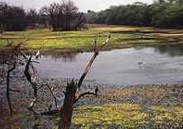|
 Hotel Sunbird is just a few hundred meters away from the main entrance to Keoladeo National Park, also known as Bharatpur Bird Sanctuary. It is a paradise for the avian world, and bird watchers. The importance of the site is recognized with its designation as Ramsar Site (1981) and as a World Heritage Site in 1985. Hotel Sunbird is just a few hundred meters away from the main entrance to Keoladeo National Park, also known as Bharatpur Bird Sanctuary. It is a paradise for the avian world, and bird watchers. The importance of the site is recognized with its designation as Ramsar Site (1981) and as a World Heritage Site in 1985.
The geographical location is ideal as it is on the main North - South avian route of India. Although small in size, 29 sq. km. only, it boasts of housing more than 375 species of beautiful birds. More than 132 of them breed inside the National Park and nearly every year new ones are added to the list. The sanctuary not only attracts birds from India but also from places like Europe, Siberia, China and Tibet.
 Before the monsoon hundreds of these exotic birds roost and nest-building activities start on the babool and kadam trees of the park. Water coming through the Ajan Bandh starts filling the various ponds and lakes of the Park. Before the monsoon hundreds of these exotic birds roost and nest-building activities start on the babool and kadam trees of the park. Water coming through the Ajan Bandh starts filling the various ponds and lakes of the Park.
When assured of enough food, hundreds of large, medium and little cormorants, darters, purple and Grey herons, various species of egret, painted, open-billed, white necked and black necked storks, white ibis, spoonbills, night herons and other birds get busy in courting and mating. The trees are overloaded with nests; one can observe a tree housing upto fifty or sixty nests, belonging to different species of birds looking after their young. Gracious Saras cranes, the tallest flying birds nest in exposed and open areas, both partners share the duty of incubating the eggs. They perform beautiful displays - coming together they raise their neck and make shrill trumpetic calls in unison and at the same time fan their feathers. The newly born chicks are only 10 cm. in size but grow upto one meter in height within a year.
 As the monsoons arrive birds from every part of the country start pouring into the park. Migratory water-fowl, including the pride of Keoladeo, Siberian Cranes, form the indispensable part of Park. The water-fowl visit the park in thousands during the month of October. The most noticeable water-fowl coming to the park are barheaded and greyley geese. As the monsoons arrive birds from every part of the country start pouring into the park. Migratory water-fowl, including the pride of Keoladeo, Siberian Cranes, form the indispensable part of Park. The water-fowl visit the park in thousands during the month of October. The most noticeable water-fowl coming to the park are barheaded and greyley geese.
Ducks include ruddy shelduck, redcrested pochard, spot-billed duck, comb duck, garganey etc. Predatory birds like imperial eagle, steppe and tawny eagle, spotted eagle, marsh harrier and laggar falcon are attracted towards the park completing the avian food chain of the ecosystem. Some of them, like short-toed eagle, lesser spotted eagle and shikra are the residents of Park.
 About 11 sq. km. area of the park is covered with water, but there are wooded areas and extensive grassland in winter. Other species include Kingfisher, Red Vented and white cheeked Bulbuls, Babblers, Quails, Partridges, Sunbirds, Sparrows and Parakeets, which live in bushes and burrows. The amazing diversity of birds attracts ornithologists from all over the world. About 11 sq. km. area of the park is covered with water, but there are wooded areas and extensive grassland in winter. Other species include Kingfisher, Red Vented and white cheeked Bulbuls, Babblers, Quails, Partridges, Sunbirds, Sparrows and Parakeets, which live in bushes and burrows. The amazing diversity of birds attracts ornithologists from all over the world.
Several species of mammals can also be seen. These include the Black Buck, Sambhar, Spotted deer, and Nilgais (the Blue Bulls) - the largest Indian Antelope. Pythons can also be observed at some places lazying in the sun.
Vehicles are only permitted upto Shanti Kutir inside the park. The Electra Van of the forest department can be engaged in the sanctuary, although the best way to explore the park is on foot or bicycles which are available on hire. Cycle rickshaws can also be hired, along with numerous guides who have excellent bird identification and observation skills.
Park particulars: The Park is open all year from dawn to dusk. In winter the cycle-rickshaws get out of the Park by 6 pm. Entrance and camera fees (both nominal) are paid at the gate and checked inside at the barrier. Cycle-rickshaw guides charge INR 50/hour. Freelance naturalist Guides are also available @ INR 100/ hour. You will need naturalist Guides in case you want to explore areas outside the beaten track. Bicycles are no longer allowed inside the Park (Feb 2009). Bharatpur has a network of tracks and many run along the water-bodies. They are best explored on foot.
Strategy: 4-5 days are recommended if you are new to Keoladeo. Use a Cycle-rickshaw guide for a couple of days to get your bearings. Explore on foot thereafter.
|

